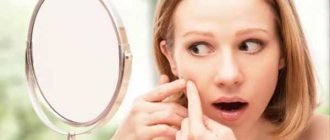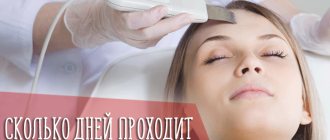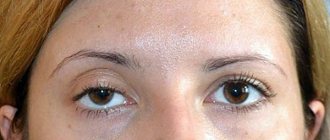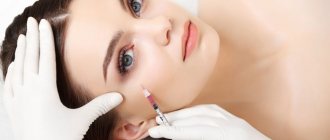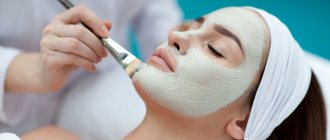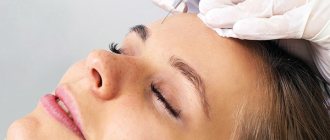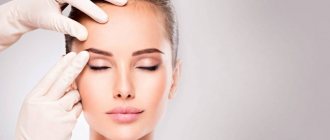Can acne appear after cleansing your face?
The occurrence of acne can be associated with the characteristics of the chosen procedure. Adjust for its type and understand what is happening to your skin.
After mechanical cleaning
If acne suddenly appears after mechanical cleansing of the face, the reason may be as follows:
- the cosmetologist injured the skin when removing sebaceous plugs, and the skin became inflamed;
- the technology was violated (the doctor neglected to steam or did not apply a mask to close the pores);
- the cause was insufficient sterilization of instruments, which led to infections;
- cleansing was carried out without taking into account contraindications and caused an exacerbation of herpes;
- the skin has been exposed to aggressive environmental influences;
- you started using decorative cosmetics, including foundation, too early.
A specialist whom you contact for help will help determine the cause. But even if the technology was not violated, after mechanical cleansing the integument will be inflamed. Sometimes redness and swelling form in the area where deep comedones were located. You may mistake them for new pimples, but with proper care, the complication will disappear in a couple of days.
After ultrasonic cleaning
Rashes after ultrasonic cleansing, as after mechanical cleansing, can be caused by poor sterility, improper care, or ignoring contraindications. But the following is added:
- in rare cases, ultrasound intolerance occurs;
- if part of the deep plug remains in the pore, inflammation is possible;
- if there are undetected subcutaneous pimples, ultrasonic waves act on them like a massage, and the inflammation spreads.
To avoid unpleasant consequences, make sure the qualifications of the chosen cosmetologist. He should ask questions about your state of health and the presence of infectious diseases. A prerequisite is still a story about possible complications: the doctor needs to make sure that you correctly understand the risks.
The reason is not only the lack of qualifications of the specialist, but also increased sensitivity of the skin. Sometimes the reaction to steaming or using clay masks causes deterioration. If you know about this feature, warn your cosmetologist. In this case, he will make a mask to narrow pores only on the problem area, covering the forehead, nose, and chin. Moisturizers are used for the skin of the cheeks.
Causes of acne and their prevention
The main reasons why acne may appear after peelings are divided into three categories: cosmetic, dermatological and household. Fans of superficial and medial exfoliations turn to specialists with complaints of inflammatory rashes on the face. Pustular pustules can irritate the skin both with a light glycolic peel and as a result of a serious retinoic peel. So, let's find out why acne appears after peeling.
Cosmetic causes of acne:
- inappropriate exfoliation. Not all ages are susceptible to peelings. For example, young skin does not allow medium or deep exfoliation. Up to the age of 25, cosmetologists recommend getting rid of aesthetic imperfections only with the help of rare superficial techniques - soft fruit peelings or ultrasonic facial cleansing. More severe exfoliation at a young age will likely cause inflamed bumps to appear on the skin. Radical cleansing is allowed to be performed no earlier than 25-30 years. And only if there really is evidence for it;
- improper pre-peeling preparation is another cosmetic reason for the appearance of purulent pustules. On the eve of peeling, many experts advise preparing the skin for the procedure. How exactly depends on the type of skin and the cause of their imperfections. For example, for those with oily or combination skin with clogged and enlarged pores, comedones or acne, it is advisable to perform a manual or ultrasonic cleaning session 3-4 days before peeling. And for those who often suffer from herpes, take the antiviral drug Acyclovir a week before exfoliation;
- violation of post-peeling care rules. After peeling, acne may break out if a woman violates the protocol of care procedures. For example, in the first few days he touches his face, especially with dirty hands, picks off dry crusts, tries to disguise peeling with decorative cosmetics, does not cleanse the skin of the remnants of nourishing creams and masks;
Dermatological causes of acne:
- infection of the skin by the Demodex mite. Before the exfoliation procedure, a woman may not be aware of the presence of this parasite in her body. Demodex develops in the sebaceous glands and hair follicles, causing extensive redness, inflammation and itchy ulcers. Subcutaneous mites can only provoke worsening of acne and furunculosis after peeling - the face takes on a terrible appearance, inflamed nodules do not go away for up to 2-3 weeks. Cosmetologists must prescribe tests for Demodex and Staphylococcus to patients before a course of peeling procedures. And in case of a positive result, carry out drug therapy;
- stress for the sebaceous glands. In response to an acid irritant, the sebaceous glands can increase secretion production. In this case, the next day after peeling, a pustular bump may appear on the face;
- hormonal imbalance associated with hormonal therapy, chronic diseases of the endocrine system or taking contraceptives.
Household causes of acne:
- visiting a bathhouse or sauna during the period of skin rehabilitation after exfoliation;
- physical activity that provokes increased sweating in the first 3-4 days after peeling.
What rashes after cleansing are considered normal?
Should acne always be a cause for concern? The answer comes from cosmetologist Kate Sommerville, who is regularly consulted by Jessica Alba and Lauren Conrad. She claims that after cleansing, the skin gets rid of toxins and impurities, which is why it breaks out. In most cases, they resolve without additional interventions.
When you go to a salon for treatment of ulcers, acne and blackheads, be prepared for the fact that immediate transformation will not happen. After all, we have to eliminate pollution that has accumulated over the years! Remains of cosmetics, sebum, dirt are hidden deep in the pores. When a doctor cleanses and uses masks for detoxification, the plugs seem to be pulled out. You will need to wait: when the resulting rashes go away, the skin will become clear.
How do you know that the defects that appear are a common occurrence that will disappear in a few weeks? Pay attention to their type, because after cleansing, small pimples with pus appear on the face. Use masks recommended by a cosmetologist and reduce the appearance.
If you decide to clean your face with chemical or vacuum peels, then an aggravation will be natural. After all, a layer of dead skin cells is removed from the skin, and the imperfections hiding underneath become more noticeable. After 2-3 weeks the problem disappears.
An opinion on the issue is expressed by Pablo Pritchard, a practicing plastic surgeon from the USA. He claims that acne after chemical peels is normal. Sometimes acne occurs even in cases where the skin seemed healthy before cleansing. The fact is that peelings accelerate the production of skin cells and stimulate all processes. Small pimples that would have formed later form faster.
A rash also occurs because you have removed the manifestations, but not the cause of the disease. It is important that you understand the results that can be achieved by cleansing your pores. A procedure with a cosmetologist is not the application of makeup, which is aimed at immediately hiding defects. Cleaning is comparable to working out at the gym: you don’t expect to become beautiful after just one visit. You will see the benefits of the process in a few days when the skin recovers.
How to properly clean?
- The skin must be prepared before cleaning. Preparing the skin involves high-quality cleansing (washing) with the maximum possible degreasing. To ensure effective subsequent healing of skin damaged during cleansing, it is necessary to strengthen local microcirculation. Previously, for this purpose, the skin was steamed in a water bath, but now special warming lotions (usually camphor-based) are used. It is possible to use light peeling (or microdermabrasion) for a keratolytic effect - this will facilitate the process of emptying the elements, reduce skin trauma and speed up subsequent healing.
- The cleaning procedure must be carried out in compliance with all aseptic rules. Be sure to use disposable gloves. All instruments must be sterile, or better yet, disposable. Before and after the procedure, the skin must be treated with an antiseptic solution.
- The procedure itself should be carried out as gently as possible. Auxiliary tools for manipulation are usually an Unna spoon and a sterile disposable needle. The potential danger of cleansing is that damaged but not completely emptied follicles very quickly become inflamed and suppurate. To avoid this, I strongly recommend expanding the comedones or pustules with a sterile needle, and piercing the milia. After such a simple manipulation, much less effort is required to empty the element, the surrounding tissue is not injured, and pain is reduced. The needle for these purposes should not be thin; 22G needles for intramuscular injections are usually used.
- After cleaning, be sure to treat the skin with an alcohol-based antiseptic solution or a special anti-inflammatory lotion.
- It is necessary to complete the cleansing procedure by creating optimal conditions for soothing and speedy healing of damaged skin. For this purpose, enzyme masks, microcurrent therapy, soothing and moisturizing applications are used. Previously, only masks that dried and narrowed the pores were used to complete the cleansing, but now this approach is outdated. Only very thick and very oily skin will withstand the stress of trauma and double degreasing during the cleaning process. For sensitive skin, this is a reason for irritation and increased inflammation. Therefore, at the end of cleansing, the skin must be soothed and moisturized as much as possible. Only individual elements at the very end of the procedure should be spot-treated with special drying lotions. But remember that after cleansing, you should not apply creams and masks with a thick, oily texture to the skin - they are potentially comedogenic and can provoke the development of inflammation.
If you follow all these rules, then cleaning is easy, the patient does not need to sit at home for several days, all removed elements heal quickly, and the skin really becomes cleaner.
What rashes after cleaning are dangerous?
Although the appearance of acne is normal, in some cases you should rush to see a dermatologist:
- Bright red, rash-like areas appear after chemical burns.
- When the face becomes covered with small itchy pustules, this indicates an allergic reaction. It is caused by products used after cleansing and care products. There are cases where patients showed intolerance to the component included in the cream with protection from ultraviolet rays.
- Deep subcutaneous acne occurs when the cosmetologist used a product that was too greasy when cleaning. You should not squeeze pimples, as this can lead to infections.
If in doubt, do not try to figure out on your own how dangerous the rash is. Contact the cosmetologist who performed the procedure or a dermatologist.
Rashes on the face can be caused by various factors: stress, temporary hormone imbalance, and an allergy to a product you ate before or after the procedure play a role.
Prevention
To protect against the side effects of facial cleansing, you should avoid drinking alcoholic beverages, fatty foods, quit smoking, and drink enough water daily. It is imperative to treat the skin of your face with moisturizers. The pillow cover should be changed daily.
Deep cleaning will significantly rejuvenate the face, eliminate acne and sebaceous plugs. Following the recommendations will minimize the likelihood of developing complications in the form of inflamed pimples and redness.
Side effects after cleaning
After cleansing the pores, pimples, redness, and slight swelling may appear on the face. To determine whether symptoms remain within normal limits, pay attention to the type of rash.
What to do when acne breaks out on your face
Even old pimples became inflamed after the procedure in the salon? It is highly likely that the doctor introduced an infection. Hurry to the dermatologist so that he can prescribe an antibacterial agent. And to relieve symptoms, wipe the skin with a solution of salicylic acid or chamomile decoction.
Ulcers appeared
A few pus-filled pimples shouldn't cause you any concern. Anoint the inflamed area with Baziron or Zenerite, applying them to the acne. You cannot cover your entire face with medications.
If there are many rashes, consult a doctor.
Herpes made itself known
Have you been waiting for the appointed day of cleaning and did not notice that a small bubble appeared on your lips? Don’t be surprised that after the procedure, vesicles—cavities filled with liquid—formed on your face. They look like pimples, but in fact, herpes makes itself known.
The problem also arises for those who have not complained of a viral infection: trauma to the nerve endings during cleansing becomes a provoking factor. A dermatologist will help you: he will prescribe a course of acyclovir. Take 1 tablet 5 times a day, and after 5 days the rash will disappear.
Vesicles during exacerbation of herpes
What water is better to wash your face with?
After most cleansing, the skin is partially stripped of the stratum corneum of the epidermis. Although this prevents the appearance of rashes, the protective properties of the integument are weakened. To ensure a gentle effect on the skin, wash your face with boiled or mineral water (choose a non-carbonated variety).
How quickly does redness go away?
When you visit a salon and have your pores cleaned, you want to become beautiful as quickly as possible. But redness remains the norm: if the cosmetologist worked professionally, the problem will disappear after 3 days. In some cases, redness disappears 6 days after the procedure.
Treatment methods
If dangerous acne appears after cleansing your face, you should urgently visit a specialist. It is forbidden to try to squeeze out the formations yourself, as there is a high risk of infection.
Self-medication is dangerous with complications!
Attention
Despite the fact that our articles are based on trusted sources and have been tested by practicing doctors, the same symptoms can be signs of different diseases, and the disease may not proceed according to the textbook.
Pros of seeing a doctor:
- Only a specialist will prescribe suitable medications.
- Recovery will be easier and faster.
- The doctor will monitor the course of the disease and help avoid complications.
find a doctor
Do not try to treat yourself - consult a specialist.
Only an experienced dermatologist will select adequate therapy. Antibacterial drugs and antiviral agents are often prescribed to eliminate the defect.
The appearance of harmless rashes does not pose any threat. To speed up the regeneration process and eliminate the rash, you need to treat your face with an antimicrobial drug, salicylic alcohol. A thin layer of antibacterial ointment, synthomycin emulsion, should be applied to the affected area.
Why can our articles be trusted?
We make health information clear, accessible and relevant.
- All articles are checked by practicing doctors.
- We take scientific literature and the latest research as a basis.
- We publish detailed articles that answer all questions.
During the recovery period, a warm decoction of chamomile, sage or calendula is suitable for washing to eliminate bacteria and relieve inflammation. Every day you need to apply a clay mask to your face for 15 minutes.
During rehabilitation, spicy, fatty foods, and alcoholic drinks should be excluded from the diet. It is not recommended to play sports, visit the sauna, bathhouse and other stuffy places. If the procedure was performed correctly, the redness will disappear on its own within three days. Sometimes it takes a week to recover.
Additional causes of acne after cleansing
In addition to the reasons listed, the appearance of acne can be caused by your habits. After the procedure, the protective functions of the skin are weakened, and a previously harmless factor provokes a problem:
- Pimples appear on one side of the face, and the rash extends from the ear to the corner of the mouth? Most likely it's a smartphone issue. When you touch the screen, bacteria from your hands fall onto the surface; then, when talking, you press the gadget to your face.
- After the procedure in the salon, you could replace your skincare products. Although the results are usually positive, in some cases the skin reacts with redness and rashes.
- Did your cosmetologist recommend probiotics? The product gets rid of acne, but sometimes the effect is the opposite. If the situation does not improve after a couple of weeks, contact the professional who performed the cleaning.
- If you use regular tap water to wash your face, there is a risk that it contains metals that cause allergies. Before cleansing, the skin was protected by a layer of keratinized cells, and intolerance did not make itself felt. In addition, metals in water oxidize on the skin, which affects pH levels. As a result, rashes do not take long to appear! To avoid this phenomenon, use boiled water or install filters.
- After cleaning, you can take care of it with such zeal that you cause damage to the integument. Of course, a one-time visit to the salon is not enough if you have naturally oily skin. But you should wait with intensive procedures, and after the recovery period, do not overuse skincare products. To problem areas, just apply a product from North American Herb and Spice: Oreganol P73 you can buy on Amazon.com.
Still have questions about how to avoid acne after cleansing your face? Watch a video about proper care: follow the recommendations, and you will be able to forget about acne or blackheads.
Why do acne appear?
Pimples are frequent “guests” on a woman’s face at any age, and they are provoked by several reasons that are worth familiarizing yourself with. The main reasons are:
- The presence of inflammatory processes in the body;
- Hormonal imbalances;
- Oily, rough, porous skin;
- Increased production of sebum by the skin;
- Violation of intestinal microflora;
- Incorrectly selected cosmetic products;
- Abuse of sweet foods;
- Improper general nutrition;
- Demodecosis.
Every skin needs proper care, and as for problematic skin, it deserves double care and attention. For this, there are many beauty treatments in the salon, as well as home recipes that give exactly the same effect, protect the skin from rashes, prevent acne and fight acne.
If there are serious problems on the face that really make you think about the presence of concomitant serious diseases, it is worth visiting a doctor who will determine the danger of the manifestation. If these are ordinary blemishes on the skin that do not hide a danger, they can be easily gotten rid of with the help of natural home remedies that can be prepared very quickly.
Treatment of the consequences of cosmetic procedures
When a rash appears, it is important not to self-medicate, but to go to a specialist. He will determine the cause of the rash and take action. Can't visit a cosmetologist-dermatologist immediately? In this case, try the following:
- Wash your face with a warm decoction of herbs: chamomile, calendula and sage will relieve inflammation, soothe the skin, and eliminate harmful bacteria.
- Wipe your skin with a salicylic acid solution. The component is included in many expensive products, but you can buy a bottle at any pharmacy: the cheapness will not affect the effectiveness.
- Make masks with cosmetic clay, which normalizes the activity of the sebaceous glands.
- Do not squeeze pimples, otherwise you risk getting an infection. Even if bacteria does not enter the wound, there is a chance that a scar will remain on the face later.
Still, you should not delay visiting a specialist, especially if the situation does not begin to improve within a few days.
How to understand that your cleaning was done poorly
It can be difficult to know whether rashes remain within normal limits. But if you notice a number of alarming signs during cleansing, and then your face breaks out in pimples, it’s time to rush to the doctor. What does the lack of professionalism of a cosmetologist indicate?
- Before starting cleaning, a specialist must inspect the covers. While touching your face with your hands is usually a bad idea, you need to make an exception at this point. After all, a cosmetologist must evaluate how rough the skin is and understand whether it is dry or oily. If he neglects preparation, the approach will not be individual.
- The specialist will not only cleanse your face, but also look into your ears. The fact is that there are acne and pimples in the ears and passages. If you often use headphones while listening to music, then your pores are probably clogged. A good cosmetologist will definitely examine the ears and clean them.
- A cosmetologist should not shame you for your skin condition or aggressively force you to use care products. But he is obliged to give recommendations, especially if he has mechanically removed comedones. After all, the pores do not close immediately after treatment: they remain stretched, which increases the likelihood of the problem returning. If the rules of facial care have not been explained to you, it is not surprising that rashes appear again.
If you notice these mistakes by a cosmetologist, and then you have complaints about the results, consult your doctor about your skin condition.
Consequences
Facial cleansing has a number of consequences that go away quite quickly if you properly care for your skin:
- Redness.
- Pimples.
- Inflamed formations.
- Peeling.
- Swelling.
If the procedure is carried out incorrectly, small scars and other irregularities may appear, infection may enter the body, and general health may deteriorate.
How to remove redness?
A reminder on how to avoid redness:
- Carry out deep cleansing of the skin of the face exclusively in beauty salons and centers, as there are the most suitable conditions for such a procedure.
- Choose a qualified and experienced cosmetologist whom you can safely entrust your face to.
- Make sure that after the procedure the cosmetologist makes a mask for your face, since it is this that soothes the dermis and narrows enlarged pores.
How to wipe off redness?
Redness usually goes away within 2 days after the procedure. However, what if this does not happen? Remedies to eliminate redness:
- Facial gel with aloe vera extract.
- Chamomile decoction (can be used both in liquid and frozen form).
- Lactic acid (can be replaced with curdled milk, which has recently curdled).
- Green tea.
You can also use anti-inflammatory compresses and masks based on medicinal plants, which will help quickly eliminate unwanted redness.
What to do if acne appears?
Almost everyone, after cleansing their face, experiences the appearance of acne, which most often appears due to deep cleansing of the pores. You can quickly eliminate them in the following ways:
- Wash your face with a herbal decoction (chamomile, calendula or sage) to eliminate the inflammatory process, soothe the skin and destroy dangerous microorganisms.
- You can wipe off unwanted pimples with salicylic acid, which can be purchased at any pharmacy.
- Make clay masks to normalize sebum secretion.
- Do not squeeze out the formation under any circumstances, otherwise you can introduce an infection into the dermis or leave scars on your face.
If the situation does not improve, then you should immediately contact your cosmetologist, who will find out the cause of the rash and find an effective way to eliminate it.
Care masks
After cleansing your face, many cosmetologists recommend making soothing masks at home to quickly restore the skin.
Recommendations
- You should not use all mask recipes in a row; it is recommended to use only those prepared on the basis of medicinal, in particular antiseptic, drugs.
- Ask your cosmetologist which mask is best to perform at home after cleansing your face.
- Before applying the mask, perform an allergic reaction test on a small area of the skin on your hands.
- If the consequences after cleansing are minor, use fruit or vegetable based masks.
- You can perform such restorative face masks only once every 3 days.
Recipes
- Mix a little blue clay, potato-based starch and talcum powder in equal proportions. At the same time, grind aspirin and chloramphenicol into powder (half a tablet each), add alum with the tip of a knife. Pour the dry mixture with a previously prepared decoction based on the string and stir thoroughly, after which the mask is ready.
- Combine white clay and talc (thirty grams each), chloramphenicol powder (fifteen grams) into one mass, then add 3% peroxide.
- Combine melted honey (thirty milliliters) with pre-chopped oatmeal (fifteen grams), after which the mass can be applied to the skin of the face.
Add chopped parsley (thirty grams) to 33% fat cream or sour cream (thirty grams). Apply the finished product to the surface of your face. Grate raw potatoes (fifteen grams) and add regular high-fat yoghurt to it until a puree-like consistency appears, after which the mask is ready for application. In yogurt, dilute yeast (ten grams) to a consistency reminiscent of sour cream, then add freshly squeezed strawberry juice (ten milliliters). Dilute Dimexide (five grams) in clean water (fifty milliliters) and wipe your face with this emulsion. After 30 minutes, apply Solcoseryl ointment to the surface of the face.
Such masks will allow you to quickly soothe your facial skin after cleansing, as well as eliminate unwanted redness, pimples and other effects of peeling.
How to take care of your face after removing rashes
Although cleansing the pores is effective, it is not enough to get rid of the problem. After all, you will eliminate the manifestations, not the causes. To get rid of acne, you should approach the issue comprehensively.
Preventing acne
First of all, determine what caused the rash on your face: sometimes they become signs of serious diseases. If your health is fine, make adjustments to your daily care.
Keep your skin clean
Why do acne appear after cleansing my face? Perhaps you are neglecting hygiene procedures. Many women do not remove their makeup before going to bed: not only fatigue plays a role, but also dissatisfaction with their appearance. Advertising imposes glamorous images so much that you are not ready to see your face without makeup! But give up the habit of sleeping “in full color.” Wash your face in the morning and evening: 2 times a day is enough.
Use products for your skin type
Many acne treatments contain drugs that dry out the skin. Make sure to moisturize, but look for the “non-comedogenic” label on bottles. Manufacturers offer products for oily, dry and combination skin.
Don't overuse cosmetics
A thick layer of foundation, powder, blush - their use leads to the formation of blackheads and rashes. Apply makeup sparingly and choose non-comedogenic products. Also examine the bottle: look for an oil-free formula with minimal fragrance.
Avoid long periods of sun exposure
Exposure to ultraviolet radiation causes irritation and increases the risk of inflammation and hyperpigmentation. Always use a sunscreen with SPF 30, but make sure the product you choose is non-comedogenic.
If you're going to the beach, reduce your sun exposure, especially between 10 a.m. and 2 p.m.
Watch your diet
Dermatologists have concluded that chocolate, previously considered harmful, does not cause breakouts. But diet affects the condition of the integument, so exclude fatty and junk foods from your diet. Dairy products and foods with a lot of sugar are also not good for acne. Focus on fruits and vegetables to keep your skin glowing with beauty.
If you're struggling with breakouts on your face, it's important to have faith in the results. Dermatologists assure: some patients are so worried about pimples that they bring themselves to stress. They provoke the development of new acne, and treatment is ineffective. Stop stressing about your appearance and your chances of success will increase.
How to clear acne from your face at home?
Home procedures for cleansing facial skin from acne use substances that are available in every home. Effective remedies are lemon juice, soda, and salt. These cleansing methods are not suitable for everyone, and the results may sometimes not be as expected.
Steaming
Before a facial cleansing session, steaming is used, which has a lot of useful properties:
- hot air, steam penetrates the deep layer of skin and melts sebum, along with which dirt, dust and cosmetics come to the surface;
- pores expand for deeper penetration of nutrients from peelings and masks;
- steam disinfects pores, fights acne and inflammation;
- the skin is enriched with oxygen;
- useful for mature skin, as it activates collagen production;
- prepares the skin to clean out old impurities from the pores.
How to properly steam the skin so as not to harm the body. Before deep cleansing your face at home, you should steam your skin using the classic method:
- Remove makeup, wash well.
- Remove hair from the face using an elastic band, headband, or bandage.
- Pour hot water into a cup.
- Place your face above the evaporation at a comfortable temperature, but avoid hot air so as not to burn your skin.
- Cover your face with a towel or blanket.
- You need to steam the pores for 10 – 15 minutes.
- Remove the towel and pat your face dry with a napkin.
Steaming can be done as a separate procedure or in preparation for cleaning. Additional products for the procedure have proven themselves well: miramistin, hydrogen peroxide, tea tree oil, lemon and parsley.
Contraindications for steaming:
- Heat.
- For eye diseases, including when wearing lenses.
- Spider veins.
- Enlarged pores.
- Asthma and bronchial diseases.
- Pregnancy.
Mechanical cleaning
After steaming at home, you can carry out mechanical cleaning, because the skin will be prepared and will respond gently to the use of special tools or simply squeezing out unwanted spots and pimples. It is most convenient to use your fingertips. At home, it is difficult to carry out an effective procedure so that it does not provoke new rashes and inflammations. There is a risk of infections that can cause more serious problems.
Masks
Masks are used to provide a gentle effect on the facial skin of various beneficial substances. They moisturize, relieve inflammation and continue caring for the epidermis after the cleansing procedure.
Clay masks. Clay masks are considered an effective remedy. Clay can be purchased at a pharmacy. They are very simple to use: pour the powder into a bowl, add water and stir well until smooth. Apply to skin and wait for it to dry. Rinse off with warm water.
Coffee masks. Ground natural coffee should be used. A mask made from coffee and honey is suitable for moisturizing and gently polishing the skin. Mix a tablespoon of honey and the same amount of coffee. Apply for 15 minutes, then remove with warm water.
Egg mask. Protein perfectly fights the formation of inflammation and acne, and dries out rashes. Simply mix egg whites with clay and apply to the skin. As soon as it starts to dry out and tighten the pores, wash it off.
Salt mask. Salt is not only peeling, but also disinfects the skin. This mask is suitable for skin with blackheads and acne. Mix salt and soda in equal proportions and apply to face. Rinse off after 15-20 minutes and apply a moisturizer.
Scrubs
Natural ingredients for the scrub are used - coffee grounds, soda, oatmeal. This procedure does not require large financial investments; all products can be found in the kitchen.
Oatmeal scrub. Pour boiling water over a few tablespoons of oatmeal and add a little honey. Distribute the mixture with massage movements throughout the face. Aging and tired skin is transformed. Oatmeal neutralizes the accumulation of fatty deposits in the pores. After several procedures, the skin becomes more toned and elastic.
Sugar scrub. Perfectly exfoliates the skin, evenly cleanses the surface of unevenness. If you have sensitive skin, it is better not to use the product. You can scrub with brown or white sugar.
Coffee with yogurt. Suitable for oily and combination skin. Just 15 minutes on your facial skin helps restore its radiance and eliminate flaking. The abrasive particles of coffee cleanse, and the rich yogurt envelops and moisturizes.
Aspirin scrub. Aspirin helps remove inflammatory processes from the surface of the skin, eliminate the formation of new acne and get rid of comedones. The pores are noticeably narrowed, while the oily shine disappears for a long time. Mix one aspirin tablet with water and rub over your face.
Anti-acne masks after cleansing the face: recipes and rules
After visiting the salon and cleansing your pores, you can’t do without masks. But don’t try to try everything that the cosmetics store offers: a cosmetologist will give recommendations. If you are developing care yourself, pay attention to the products that have received positive reviews:
- Peter Thomas Roth Therapeutic Sulfur Masque Acne Treatment Masque relieves acne and post-acne. The composition includes aloe extract, kaolin, bentonite clay. Action time: 10 minutes.
- The Mario Badescu brand became famous when Kylie Jenner advertised it online. Women rushed to make a purchase... and appreciated the result! Drying Mask contains calamine and sulfur to dry out pimples. It can be applied to the face, chest and back.
- Kate Somerville offers Mask Foam-Activated Acne Treatment. According to reviews, the formula helps get rid of existing rashes. After all, the sulfur included in the composition helps cleanse the pores. And to relieve inflammation, the creators added extracts of honey, bran and rice. As a result, the functioning of the sebaceous glands returns to normal.
- GlamGlow combines glycolic, salicylic and lactic acids in the Super-Mud mask. As a result, blackheads and pimples disappear, and damaged skin regains health.
- Products from Tata Harper are not cheap, but the results are worth it. The formula of the product, called Resurfacing Mask, includes pink cosmetic clay, beet extract, pomegranate and willow bark. As a result, the skin becomes smooth and soft.
The cost of products ranges from $18 to $55, so you will find an option that suits your wallet.
Salon treatments: acne treatment after cleansing
To improve the cleaning result or cope with undesirable consequences, the cosmetologist recommends additional procedures in the salon. These include darsonvalization - exposure of the integument to weak current pulses. As a result, blood vessels dilate and blood circulation improves, which promotes healthy skin.
Cryotherapy, as the effects of liquid nitrogen are also called, involves combining cold with a gentle massage. The method is used in cosmetology and dermatology; it perfectly normalizes the functioning of the sebaceous glands and eliminates rashes.
The number of procedures is determined depending on the initial condition of the integument.
The essence of the procedure
Skin cleansing is called deep sanitation of pores. As a result of the procedure, internal contaminants are removed that cannot be affected by regular washing of any thoroughness.
A cosmetologist achieves his goal through the use of special tools, devices, and chemical compounds. The impact injures tissue.
Violation of the integrity of the skin does not always occur, which does not indicate the possibility of ignoring the rules of behavior or violating the principles of skin care after cleansing.
Treatment with folk remedies
It happens that it is not affordable to carry out a set of additional measures. But don’t despair, because after cleansing, acne can be removed using home methods. There is more than one recipe at your disposal:
- Green tea has antibacterial and anti-inflammatory properties. To make a mask, apply the used bag to the inflamed area. Don't forget to make sure the temperature is comfortable!
- Mint helps remove sebaceous plugs. You will need 2 tbsp. l. finely chopped plant, the same amount of homemade yogurt and chopped oatmeal. The exposure time of the mask is 10 minutes.
- Citrus juice relieves inflammation. However, after cleansing your face, it should be used carefully so as not to dry out sensitive skin. Lightly moisten a cotton swab, blot the inflamed areas, and you will soon notice improvements.
- A honey and cinnamon mask will be a source of antioxidants. It will also relieve inflammation and destroy bacteria. To get the effect, mix 1 tbsp. l. honey with 0.5 tsp. crushed cinnamon, apply to face. Leave for 15 minutes.
- Aloe vera pulp is known for its ability to soothe the skin. You can buy the gel at the pharmacy, but the result will be the same as using a home remedy. Simply peel off the transparent part and apply it to the affected area. Repeat 2 times a day.
Use home remedies carefully, as allergy symptoms may occur after cleansing. Make sure that the rashes on your face are not the result of the masks you started doing after your visit to the salon. To do this, apply a few drops of the product to the area behind the ear and wait 24 hours. If there are no alarming symptoms, apply a mask.
Are there any contraindications and harm?
Despite the popularity and gentle mode of exposure, not everyone can use it due to a number of contraindications that can only cause harm:
- Skin diseases such as eczema or dermatitis.
- Pathologies of the cardiovascular system.
- Neuralgic lesion of the trigeminal nerve.
- Pregnant women, all trimesters without exception.
- Traumatic brain injury.
- Malignant neoplasms.
- Herpes.
- Inflammatory processes with pus in the acute stage.
Complications
Most often they arise due to the inexperience of the master and his inept actions. Complex complications include infection, which will lead to sepsis, furunculosis and inflammation. Treatment is carried out in the clinic under the strict supervision of a dermatologist.
Important! Redness and slight swelling are natural for facial cleansing with ultrasound and are considered normal; they disappear within a couple of days.
Perhaps the scarring and bumpiness of the epidermis is due to the fact that the procedure was carried out incorrectly. Often this happens due to home procedures, when some steps and sequences are skipped or forgotten.
Comprehensive care after facial cleansing
Visits to the salon will not be a panacea: to prevent new acne from covering your face, take care of comprehensive care. Make adjustments for your skin type, because normal skin will require cosmetics containing chamomile extract and aloe vera. You should not get carried away with scrubbing, since once a week will be enough.
When it comes to moisturizing, choose products that do not form films on your face. Occlusive agents that create an additional protective barrier are contraindicated in your case. They are designed for those who suffer from excessive dry skin. The gels that your cosmetologist will recommend are suitable for you: their formula includes proteins and polysaccharides.
Before and after a course of cleansing
Those with oily skin should dry it gently and gently. You will be able to cope with the task if you use cleansers with ammonium or zinc lactate. Scrubbing is done 2 times a week. Take care of moisturizing, although those with oily skin often neglect this step. But applying a light serum or gel with anti-inflammatory ingredients will prevent acne from appearing.
If you have dry skin that is prone to breakouts, use oil-based cleansers. Creams with salicylic, citric or glycolic acid are suitable for care, but check their use with your cosmetologist.
Is your skin prone to acne? With any type, you will need to pay attention to cleansing. Washing should take at least 2 minutes, and during the process you should carefully walk through problem areas. Alcohol-based products are prohibited: this component will be replaced by fruit acids.
Procedure technology
The general technology of ultrasonic facial cleansing is the same and all cosmetologists follow it strictly and it consists of 3 stages.
Facial cleansing and peeling
The initial stage is to prepare the skin for ultrasound exposure. Makeup is removed and preparatory cleaning begins:
- A special product based on fruit acid is applied to the skin and washed off;
- to remove the stratum corneum, the cosmetologist warms up the skin, for this purpose it is covered with a special mask, covered with a film, which is additionally heated to warm up the epidermis as much as possible (duration no more than 5 minutes);
- After removing the film, a special lotion is applied and left for about 10 minutes, while the cosmetologist performs a light facial massage.
Ultrasonic exposure
The duration of exposure to the device does not exceed 10 minutes. A special attachment is put on it, which is passed over the skin, and through them ultrasonic waves reach the epidermis.
Right now everything that was clogged with will be removed from the pores. All this is painless, but sometimes a specialist combines this technique with mechanical manual cleaning.
Final manipulations
The face is wiped with a special composition, and then covered with a mask and left on the skin for about a quarter of an hour. Remove and cover the face with moisturizing cream or gel.
The high effectiveness of the technique lies in the comprehensive fight against problem skin.
How often can the procedure be performed?
It all depends on the indications; if there are no special recommendations, then the interval between procedures is usually 2 months. But sometimes cleaning is carried out in a course of 2-3 sessions and the interval between them is no more than 4 days.
What not to do after cleansing your face
After you clean your pores, follow these guidelines:
- Take your time to make homemade masks. Immediately after the procedure, the skin is sensitive, so wait a week to use additional products. An exception can be made only for products recommended by a cosmetologist.
- You should not resort to self-massage, because it leads to the spread of infection.
- Since chemical, vacuum and other procedures remove the layer of keratinized epidermal cells, barrier functions are weakened. To protect your skin from the aggressive action of the external environment, try to spend 2-3 days less in the air.
- Stop using a cotton pillowcase and replace it with a silk one. The recommendation is made by dermatologist Dennis Gross, who works in the USA. He says that silk or satin will not cause microtrauma to the skin during friction. In any case, the pillowcase must be changed regularly, otherwise it will become a source of bacteria. Remnants of styling products that fall onto the fabric from the hair also accumulate on it. Then they end up on your face, and irritation is not long in coming.
- Skin care products are not cheap, and you will definitely want to get the maximum effect. But if you apply them in the wrong order, it will affect the result. Start with products with a lighter texture, and only then move on to dense products.
- Don't overuse serums in hopes of achieving perfection. Crystal McElroy, esthetician from Florida, Fr. If you are trying not only to get rid of acne, but also to solve additional problems, alternate the types of serum.
Follow these recommendations, and there will be no complaints about your skin condition.
Limitations - what not to do
The cosmetologist stipulates in detail not only the care regimen, but also the rules of conduct during the recovery period. The doctor draws attention to the existence of restrictions. These include:
- Elimination of additional influences that can injure irritated tissues. For 1–2 days, it is recommended to avoid standard washing, excessive touching, using cosmetics, and performing simple procedures (masks, rinsing, compresses). It is advisable not to carry out complex treatments (biorevitalization, massage) for 2–4 weeks. You can apply makeup after 2-5 days, but it is better to maintain an interval of at least a week.
- Refusal of aggressive means. Alcohol-containing substances are used pointwise. It is better to discuss the possibility of using a separate product with a cosmetologist.
- Exclusion of an active lifestyle. In the first 2-3 days you should not sweat. It is advisable to postpone visiting the gym, swimming pool, solarium for 1–2 weeks. It is also recommended to exclude the bath, as well as the use of hot water for washing. It is better to actively sunbathe no earlier than after a month.
During the recovery period, it is advisable to avoid visiting public places with large crowds of people. It is recommended not to drink alcohol or “harmful” foods: sweet, salty, smoked, fried. During the rehabilitation period after the cleaning procedure, it is advisable not to be stressed.
The cosmetologist will tell you how long the restrictions apply in a particular case. Usually they return to normal life after 2 weeks. When complications appear, the period of restrictions increases.

